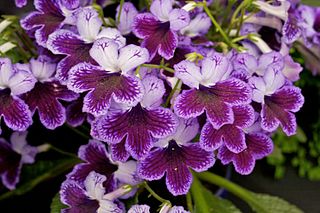
Conium is a genus of flowering plants in the family Apiaceae. As of December 2020, Plants of the World Online accepts six species.

Pierre Antoine Delalande was a French naturalist, taxidermist, explorer and painter.

Strychnos is a genus of flowering plants, belonging to the family Loganiaceae. The genus includes about 100 accepted species of trees and lianas, and more than 200 that are as yet unresolved. The genus is widely distributed around the world's tropics and is noted for the presence of poisonous indole alkaloids in the roots, stems and leaves of various species. Among these alkaloids are the well-known and virulent poisons strychnine and curare.

A popular house plant, Streptocarpus, is an Afrotropical genus of flowering plants in the family Gesneriaceae. The genus is native to Afromontane biotopes from central, eastern and southern Africa, including Madagascar and the Comoro Islands. The flowers are five-petalled, salverform tubes, almost orchid-like in appearance, and hover or arch over the plant, while the pointed, elongate fruit is of a helical form similar to that of the "tusk" of a narwhal. In the wild, species can be found growing on shaded rocky hillsides or cliffs, on the ground, in rock crevices, and almost anywhere the seed can germinate and grow. For the home, there are now many hybrids of various colours and forms available.

Momordica balsamina is a tendril-bearing annual vine native to the tropical regions of Africa, introduced and invasive in Asia, Australia, Central America, and North America, where they have been found in some parts of Florida. It has pale yellow, deeply veined flowers and round, somewhat warty, bright orange fruits, or "apples". When ripe, the fruits burst apart, revealing numerous seeds covered with a brilliant scarlet, extremely sticky coating. The balsam apple was introduced into Europe by 1568 and was used medicinally to treat wounds. In 1810, Thomas Jefferson planted this vine in his flower borders at Monticello along with larkspur, poppies, and nutmeg.

Protea comptonii, also known as saddleback sugarbush, is a smallish tree of the genus Protea in the family Proteaceae. It is found in South Africa and Eswatini.

Dierama is a genus of flowering plants in the family Iridaceae. Common names include hairbells, angel's fishing rod, fairybells, and wandflowers in English and grasklokkies in Afrikaans. They are native to Africa, with most occurring in the southern regions of the continent. The center of diversity is the province of KwaZulu-Natal in eastern South Africa.
Olive Mary Hilliard is a noted South African botanist and taxonomist. Hilliard authored 372 land plant species names, the fifth-highest number of such names authored by any female scientist.

Brian Laurence "Bill" Burtt FRSE FLS, was an English botanist and taxonomist who is noted for his contributions to the family Gesneriaceae. In a career that spanned 74 years, he worked first at the Royal Botanic Gardens, Kew, and then at the Royal Botanic Garden Edinburgh (RBGE). He made numerous field trips to South Africa and Sarawak and described a total of 637 new plant species. Burtt is denoted by the author abbreviation B.L.Burtt when citing a botanical name.

Catabrosa aquatica, called brookgrass, water whorl-grass, water whirlgrass and water hairgrass, is widespread species of semi-aquatic grass in the genus Catabrosa, native to the most of the non-tropical northern hemisphere, and to southern Chile and Argentina. As its scientific and common names suggest, it prefers to grow in wet areas, such as meadows, stream banks and lake shores.
Afroaster is a genus of flowering plants belonging to the family Asteraceae.
Polycarena is a genus of flowering plants belonging to the family Scrophulariaceae.
Chaenostoma is a genus of flowering plants belonging to the family Scrophulariaceae.
Chenopodiopsis is a genus of flowering plants belonging to the family Scrophulariaceae.
Cromidon is a genus of flowering plants belonging to the family Scrophulariaceae.

Florence Mary Paterson, née Hallack, also known as Mrs. T.V. Paterson, was a South African plant collector. Her specimens are kept in the herbarium of Albany Museum and the Bolus Herbarium of the University of Cape Town. She is honored in the plant name patersoniae and genus name Neopatersonia.
Glumicalyx is a genus of flowering plants belonging to the family Scrophulariaceae.
Globulariopsis is a genus of flowering plants belonging to the family Scrophulariaceae.
Glekia is a genus of flowering plants belonging to the family Scrophulariaceae.
Melanospermum is a genus of flowering plants belonging to the family Scrophulariaceae.









